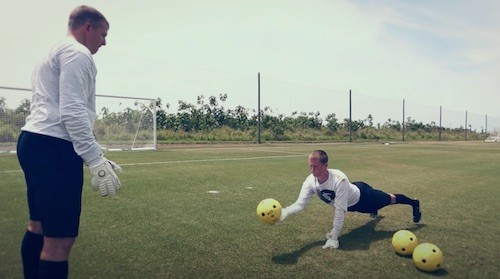All goalkeepers need to do specific weight training exercises. Although goalkeepers don’t run across or up and down the soccer field in any one game they still have to be constantly aware of the action on the field. This takes stamina and endurance, even if they’re not running up and down the field they’re often moving from side to side in the goal and out of the box. While it might not seem that tiring, it’s both mentally and physically draining, so being in shape is crucial for goalkeepers.
Above image credit goes to KwikGoal.
Goalkeeper Weight Training
Also, they must be ready and able to move quickly – backwards, forwards, and side-to-side – in a short amount of time. Explosive movements are also vital to this position, as well as throwing, kicking, and the ability to concentrate on a frenzy of soccer players all aiming at the goal! Keepers in one moment after the dart out and stop and one versus one and then come out a leap in the air to catch the ball from a whipped in corner kick.
Update: Take a look at the Coerver Goalkeeping Essentials DVD.
But goalkeepers have done some pretty unpredictable and uncharacteristic things. I’ve seen some crazy plays where keepers rush out of the box to head the ball clear, or run up for a corner kick at the end of a game. These quick sprints and movements require speed, concentration, and strength, and this is where weight lifting and plyometrics can help.
Quick reflexes are also crucial skills a goalkeeper must have. That’s right, goalkeepers need to have their reflexes, or reaction time, in tiptop shape in order to prevent the opposing team from scoring a game-winning goal. Without reflexes, the goalkeeper is nothing.
QUOTE: “The goalkeeper is the lone eagle, the man of mystery, the last defender. Less the keeper of a goal than the keeper of a dream.” – Vladimir Nabokov
Goalkeeper Weight Training: Core Strength
From the Kevin Hartman Goalkeeper Training Series. Improve the core strength of your goalkeepers with these innovative training drills. If there’s one thing that all goalkeepers need to be able to move and adjust quickly in the goal box is core strength. Foot work is of course crucial as well, and positioning, but core strength gives keepers the ability to dive and make those key saves.
The goalkeeper’s reaction time must be extremely acute and cautious to deflections, sudden shots, switches in angle of attack, and flight of the ball. These reflexes can be improved through weight lifting and plyometrics. Basically, the goalkeeper must build strength, agility, balance, and quickness through goalkeeper-specific training programs. Listed below are the recommended areas goalkeepers should strive to perfect.
• Upper body
• Lower body
• Improvement in the vertical leap
• Finger and wrist strength
• Lateral quickness
• Footwork
• Striking the ball with power and distance
At the same time though, while weight training is important for goalkeepers, it’s more about building overall strength and endurance. There are keepers who are very tall and strong, and then there are keepers who are actually quite short but extremely quick off the line. There are keepers like Brad Friedel who are tall and strong and then keepers like Iker Casillas, who’s actual quite small, compared to most keepers, but that doesn’t stop him from making incredible saves.
The key is building up enough strength so you feel confident coming off your line to win the ball and go up and win the ball when the ball comes in on a cross. There’s no need though to do so much weight training that it actually slows you down. Find the right balance that works for you, so you feel strong but also don’t lose any quickness. Often the key for keepers is building strength and flexibility at the same time.
Plus, in the modern game of soccer keepers are now required to be more involved in the possession of the ball throughout the game. Teams like Bayern Munich, Barcelona, and Manchester City all use their keepers to both keep the ball and start attacks.
While the keeper will still smash the ball down the field when under pressure, they also have to work hard to stay in the right position to receive the ball and help their defenders out when they’re under pressure from a forward. Keepers are now an outlet for a team that wants to keep possession of the ball. This requires more effort an energy from the keeper, so they have to be in better shape overall.
Extra: A Look at Manuel Neuer: How to Be the Perfect ‘Sweeper Keeper’
More Goalkeeper Information















